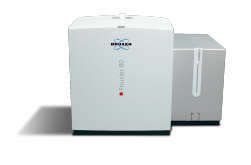Fourier 80
Big things come
in small packages

Highlights
Highlights
Eigenschaften
Features
Easy to Install: The Fourier, an 80 MHz high-performance nuclear magnetic resonance (NMR) benchtop spectrometer designed for the routine laboratory. With a cryogen-free magnet design, the Fourier makes NMR accessible in the lab where users and operators work. It can be installed in the fume hood or on the bench without the need for new infrastructure, providing easy maintenance and minimal cost of ownership. The performance of the benchtop, combined with the intuitive software, means any lab can now incorporate the definitive analytical answers only NMR can provide.
易于使用:傅里叶特征GoScan™,新developed modern interface which guides users through pre-defined, dedicated workflows. Novice NMR users can use pre-defined data acquisition choices in the GoScan software, or customize them, while experienced users can use Bruker's industry standard TopSpin™ software for more detailed acquisition parameters.
Easy to do More: The Fourier has been designed for highest data quality and stability at 80 MHz, with excellent lineshape, resolution and sensitivity in 80 MHz homonuclear 1H or heteronuclear 1H/13C FT-NMR experiments. It runs Bruker's TopSpin™ software, giving users access to the extensive TopSpin library of 1D and 2D homonuclear and proton-carbon heteronuclear experiments and pulse programs.
Click here to view special Fourier 80 content
Vorteile
Benefits
Easy to own and maintain
- Cryogen-free永磁
- No new infrastructure required
- Compact footprint
- Installs on bench or in fume hood
- Minimal cost of ownership
Anwendungen
Spezifikationen
Specifications
| Operating Frequency: | 80 MHz (1H) |
| Nuclei: | 1H-only, 1H/13C, 1H/31P or 1H/129Xe (contact us for more) |
| 1H Sensitivity: | > 160:1乙1%Benzene (1H/13C system, incl. pulsed field gradient) |
| Gradient strength: | > 0.25 T/m (25 G/cm) |
| Automation: | PAL RSI sample changer; up to 120 samples + 12 reference samples |
| 1H Resolution: | < 0.4Hz @ 50% peak height < 16 Hz @ 0.55% peak height |
| Digital Lock: | External, no deuterated solvents needed |
| Sample Tubes: | standard 5mm diameter, 7’’-long NMR tubes |
| Dimensions: | ~50 cm x 70 cm x 60 cm (Height x Width x Depth) |
| Weight: | ~94 kg |
| Lab Temperature: | 18-28°C |
| Lab Infrastructure needed: | no liquid nitrogen or helium required no water cooling required power consumption typically <300 W power: 100 – 240 V, 50 – 60 Hz no additional venting required |
Accessories
傅里叶80年与朋友肢体重复性劳损症的人
Webinare
Meinungen
Testimonials
Constance Braouet, Master Student, Hochschule Fresenius, Idstein, Germany.
Thomas Rudszuck, PhD Student in the group of Prof. Gisela Guthausen, Karlsruhe Institute of Technology, Karlsruhe, Germany.
Prof. Steven Newmaster, Purity-IQ, Guelph, Canada.
Prof. Sami Jannin, Université Claude Bernard Lyon 1, Lyon, France.
Dr. Stuart J. Elliott, Postdoctoral Research Fellow in the group of Prof. Sami Jannin, Université Claude Bernard Lyon 1, Lyon, France.
Prof. Andre Simpson, University of Toronto, Toronto, Canada.
Dr. René Jakelski, Daikin Chemical Europe GmbH, Düsseldorf, Germany.

